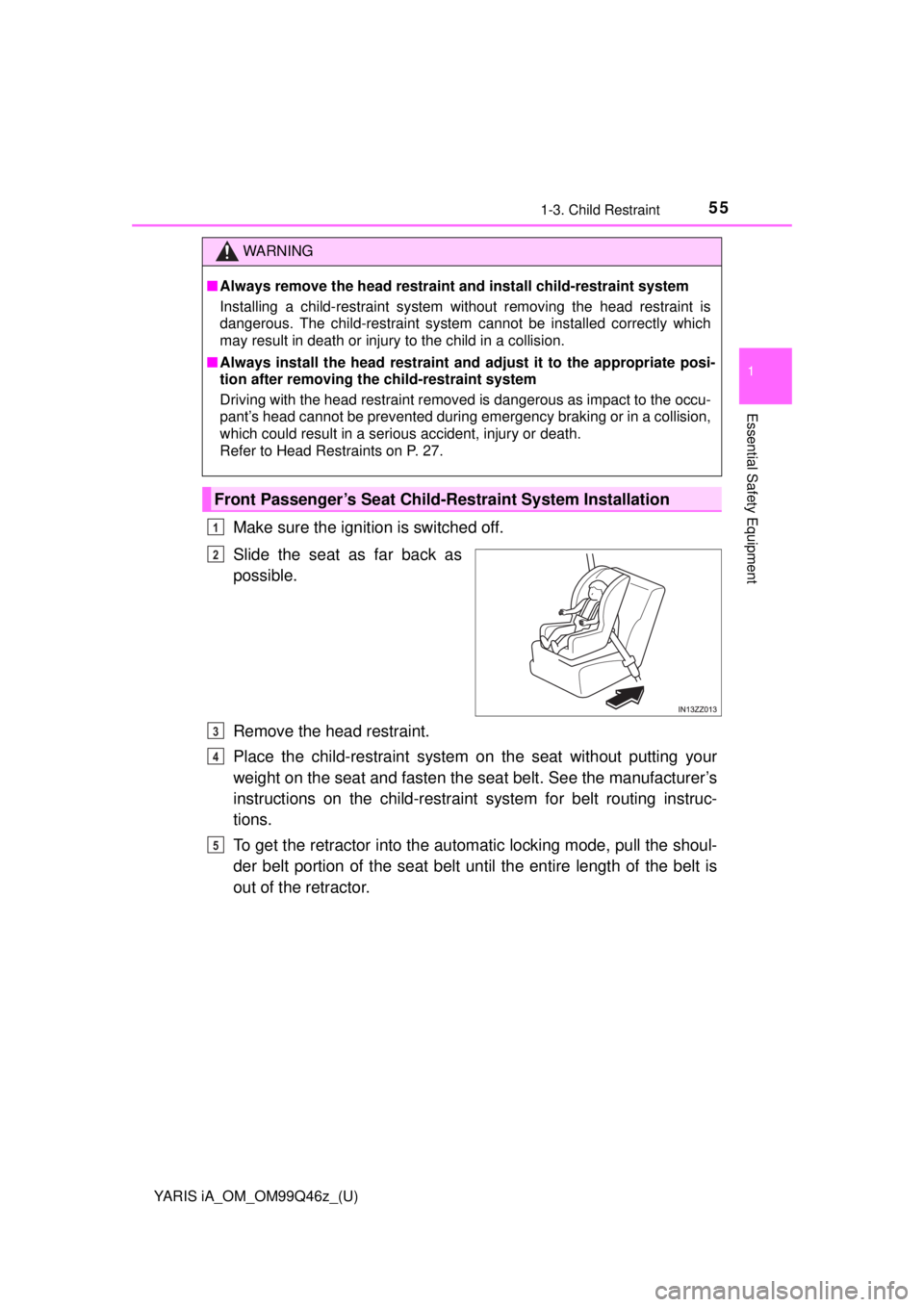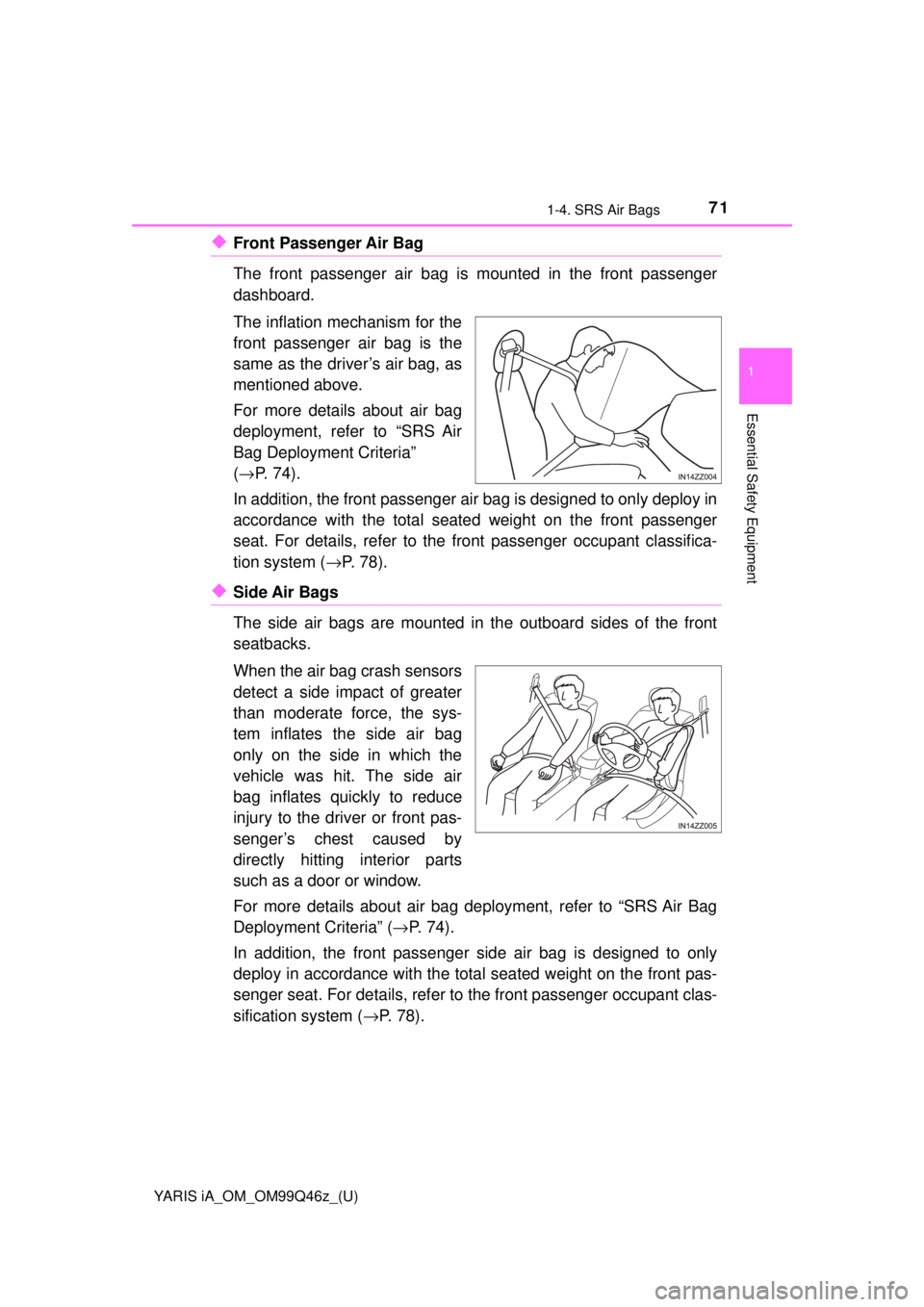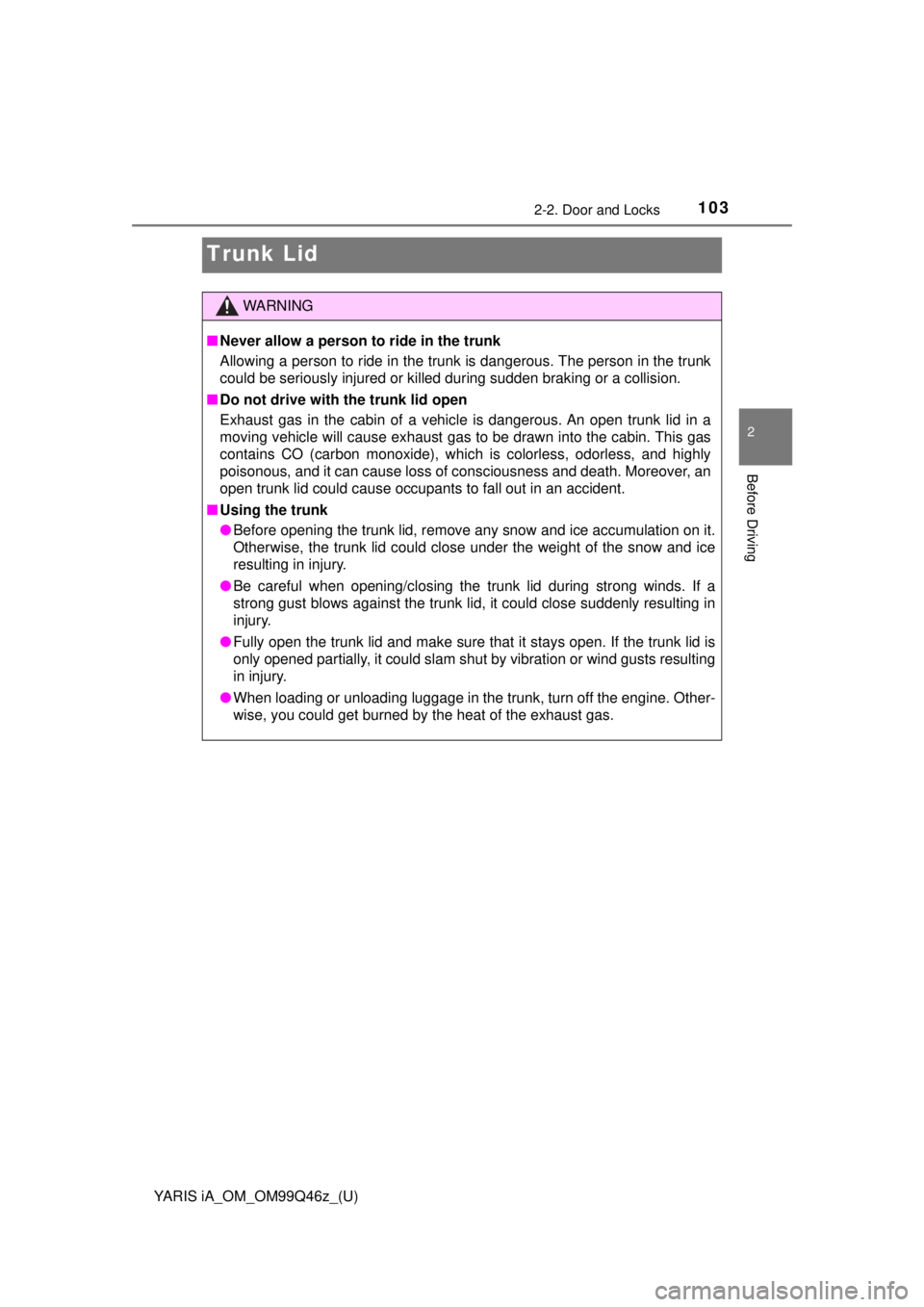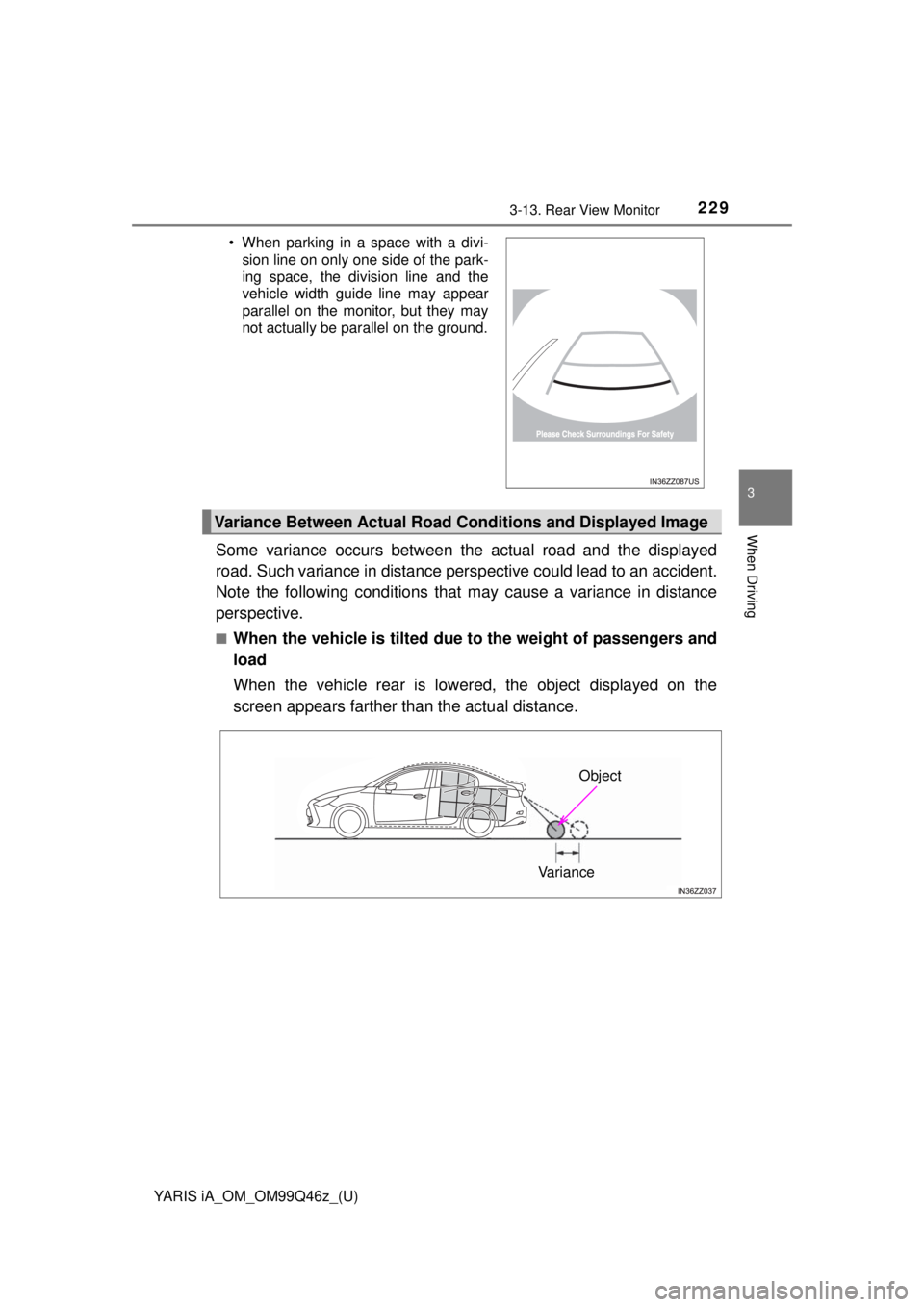2018 TOYOTA YARIS iA weight
[x] Cancel search: weightPage 55 of 576

YARIS iA_OM_OM99Q46z_(U)
551-3. Child Restraint
1
Essential Safety Equipment
Make sure the ignition is switched off.
Slide the seat as far back as
possible.
Remove the head restraint.
Place the child-restraint system on the seat without putting your
weight on the seat and fasten the seat belt. See the manufacturer’s
instructions on the ch ild-restraint system for belt routing instruc-
tions.
To get the retractor into the autom atic locking mode, pull the shoul-
der belt portion of the seat belt until the entire length of the belt is
out of the retractor.
WARNING
■ Always remove the head restraint and install child-restraint system
Installing a child-restraint system without removing the head restraint is
dangerous. The child-restraint system cannot be installed correctly which
may result in death or injury to the child in a collision.
■ Always install the head restraint and adjust it to the appropriate posi-
tion after removing the child-restraint system
Driving with the head restraint removed is dangerous as impact to the occu-
pant’s head cannot be prevented during emergency braking or in a collision,
which could result in a serious accident, injury or death.
Refer to Head Restraints on P. 27.
Front Passenger’s Seat Child-Restraint System Installation
1
2
3
4
5
Page 66 of 576

66
YARIS iA_OM_OM99Q46z_(U)
1-4. SRS Air Bags
WARNING
■Do not touch the components of the supplemental restraint system
after the air bags have inflated
Touching the components of the supplemental restraint system after the air
bags have inflated is dangerous. Immediately after inflation, they are very
hot. You could get burned.
■ Never install any front-end equipment to your vehicle
Installation of front-end equipment, such as frontal protection bar (kangaroo
bar, bull bar, push bar, or other similar devices), snowplow, or winches, is
dangerous. The air bag crash sensor system could be affected. This could
cause air bags to inflate unexpectedly, or it could prevent the air bags from
inflating during an accident. Front occupants could be seriously injured.
■ Do not modify the suspension
Modifying the vehicle suspension is dangerous. If the vehicle’s height or the
suspension is modified, the vehicle will be unable to accurately detect a col-
lision or roll-over accident resulting in incorrect or unexpected air bag
deployment and the possibility of serious injuries.
■ To prevent false detection by the air bag sensor system, heed the fol-
lowing
● Do not use tires or wheels other than those specified for your Toyota:
Use of any tire or wheel other than those specified for your Toyota ( →P. 560)
is dangerous. Use of such wheels will prevent the vehicle’s accident detec-
tions system from accurately detecting a collision or roll-over accident result-
ing in incorrect or unexpected air bag deployment and the possibility of
serious injuries.
● Do not overload your vehicle:
Overloading your vehicle is dangerous as it could prevent the air bag
crash sensor system from accurately detecting a collision or roll-over acci-
dent resulting in incorrect or unexpected air bag deployment and the pos-
sibility of serious injuries. The gross axle weight rating (GAWR) and the
gross vehicle weight rating (GVWR) for your vehicle are on the Motor
Vehicle Safety Standard Label on the driver’s door frame. Do not exceed
these ratings.
● Do not drive the vehicle off-road:
Driving your Toyota off-road is dangerous because the vehicle has not
been designed to do so. Driving the vehicle off-road could prevent the air
bag crash sensor system from accurately detecting a collision or roll-over
accident resulting in incorrect or unexpected air bag deployment and the
possibility of serious injuries.
Page 71 of 576

YARIS iA_OM_OM99Q46z_(U)
711-4. SRS Air Bags
1
Essential Safety Equipment
◆Front Passenger Air Bag
The front passenger air bag is mounted in the front passenger
dashboard.
The inflation mechanism for the
front passenger air bag is the
same as the driver’s air bag, as
mentioned above.
For more details about air bag
deployment, refer to “SRS Air
Bag Deployment Criteria”
(→ P. 74).
In addition, the front passenger ai r bag is designed to only deploy in
accordance with the total seated weight on the front passenger
seat. For details, refer to the front passenger occupant classifica-
tion system ( →P. 7 8 ) .
◆Side Air Bags
The side air bags are mounted in the outboard sides of the front
seatbacks.
When the air bag crash sensors
detect a side impact of greater
than moderate force, the sys-
tem inflates the side air bag
only on the side in which the
vehicle was hit. The side air
bag inflates quickly to reduce
injury to the driver or front pas-
senger’s chest caused by
directly hitting interior parts
such as a door or window.
For more details about air bag depl oyment, refer to “SRS Air Bag
Deployment Criteria” ( →P. 7 4 ) .
In addition, the front passenger side air bag is designed to only
deploy in accordance with the total seated weight on the front pas-
senger seat. For details, refer to the front passenger occupant clas-
sification system ( →P. 78).
Page 103 of 576

103
YARIS iA_OM_OM99Q46z_(U)
2-2. Door and Locks
2
Before Driving
Trunk Lid
WARNING
■Never allow a person to ride in the trunk
Allowing a person to ride in the trunk is dangerous. The person in the trunk
could be seriously injured or killed during sudden braking or a collision.
■ Do not drive with the trunk lid open
Exhaust gas in the cabin of a vehicle is dangerous. An open trunk lid in a
moving vehicle will cause exhaust gas to be drawn into the cabin. This gas
contains CO (carbon monoxide), which is colorless, odorless, and highly
poisonous, and it can cause loss of consciousness and death. Moreover, an
open trunk lid could cause occupants to fall out in an accident.
■ Using the trunk
● Before opening the trunk lid, remove any snow and ice accumulation on it.
Otherwise, the trunk lid could close under the weight of the snow and ic\
e
resulting in injury.
● Be careful when opening/closing the trunk lid during strong winds. If a
strong gust blows against the trunk lid, it could close suddenly resulting in
injury.
● Fully open the trunk lid and make sure that it stays open. If the trunk lid is
only opened partially, it could slam shut by vibration or wind gusts resulting
in injury.
● When loading or unloading luggage in the trunk, turn off the engine. Other-
wise, you could get burned by the heat of the exhaust gas.
Page 126 of 576

126
YARIS iA_OM_OM99Q46z_(U)
2-8. Driving Tips
Saving Fuel and Protection of the Environment
How you operate your Toyota determines how far it will travel on a
tank of fuel. Use these suggestions to help save fuel and reduce CO2.
• Avoid long warm-ups. Once the en gine runs smoothly, begin driv-
ing.
• Avoid fast starts.
• Drive at lower speeds.
• Anticipate when to apply the brakes (avoid sudden braking).
• Follow the maintenance schedule and have your Toyota dealer per- form inspections and servicing.
• Use the air conditioner only when necessary.
• Slow down on rough roads.
• Keep the tires properly inflated.
• Do not carry unnecessary weight.
• Do not rest your foot on the brake pedal while driving.
• Keep the wheels in correct alignment.
• Keep windows closed at high speeds.
• Slow down when driving in crosswinds and headwinds.
WARNING
■ Never stop the engine when going down a hill
Stopping the engine when going down a hill is dangerous. This causes the
loss of power steering and power brake control, and may cause damage to
the drivetrain. Any loss of steering or braking control could cause an acci-
dent.
Page 134 of 576

134
YARIS iA_OM_OM99Q46z_(U)
2-8. Driving Tips
Overloading
WARNING
■Be careful not to overload your vehicle
The gross axle weight rating (GAWR) and the gross vehicle weight rat-
ing (GVWR) of the vehicle are on the Motor Vehicle Safety Standard
Label on the driver’s door frame. Exceeding these ratings can cause an
accident or vehicle damage. You can estimate the weight of the load by
weighing the items (or people) before putting them in the vehicle.
Page 174 of 576

174
YARIS iA_OM_OM99Q46z_(U)
3-3. Transaxle
■Passing
For extra power when passing another vehicle or climbing steep
grades, depress the accelerator fully. The transaxle will shift to a
lower gear, depending on vehicle speed.
Some models:
The accelerator pedal may initially feel heavy as it is being depressed,
then feel lighter as it is depressed further. This change in pedal force
aids the engine control system in determining how much the accelerator
pedal has been depressed for performing kickdown, and functions to
control whether or not kickdown should be performed.
■
Climbing steep grades from a stop
To climb a steep grade from a stopped position:
Depress the brake pedal.
Shift to D or M1, depending on the load weight and grade steep-
ness.
Release the brake pedal while gradually accelerating.
■Descending steep grades
When descending a steep grade, shift to lower gears, depending on
load weight and grade steepness. Descend slowly, using the
brakes only occasionally to pr event them from overheating.
Driving Tips
WARNING
■Do not let the vehicle move in a di rection opposite to the direction
selected by the selector lever
Do not let the vehicle move backward with the selector lever in a forward
position, or do not let the vehicle move forward with the selector lever in the
reverse position. Otherwise, the engine may stop, causing the loss of the
power brake and power steering functions , and make it difficult to control
the vehicle which could result in an accident.
1
2
3
Page 229 of 576

YARIS iA_OM_OM99Q46z_(U)
2293-13. Rear View Monitor
3
When Driving
Some variance occurs between the actual road and the displayed
road. Such variance in distance perspective could lead to an accident.
Note the following conditions that may cause a variance in distance
perspective.
■When the vehicle is tilted due to the weight of passengers and
load
When the vehicle rear is lower ed, the object displayed on the
screen appears farther than the actual distance.
• When parking in a space with a divi-
sion line on only one side of the park-
ing space, the division line and the
vehicle width guide line may appear
parallel on the monitor, but they may
not actually be parallel on the ground.
Variance Between Actual Road Conditions and Displayed Image
Object
Variance